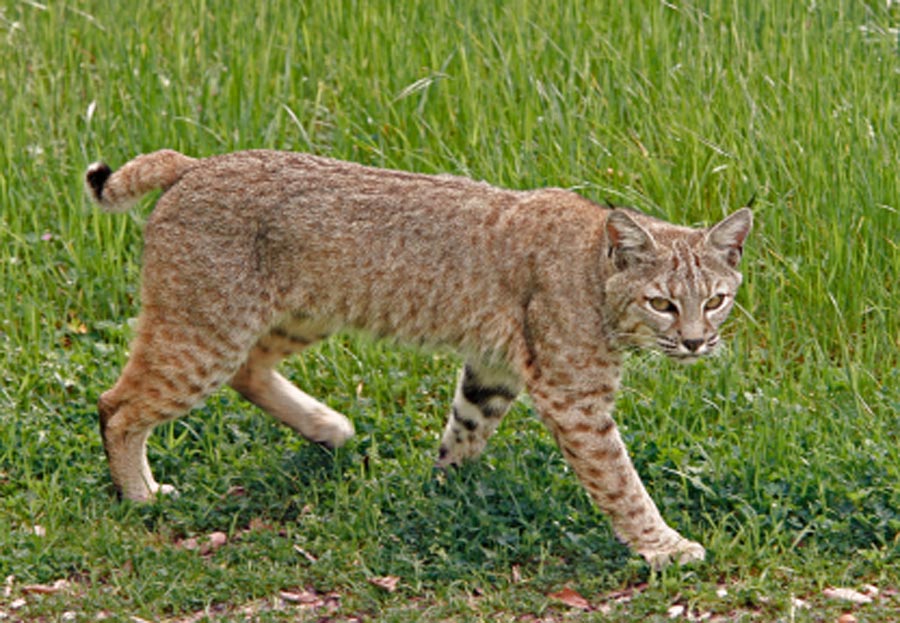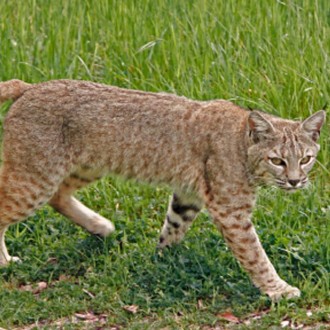


How to Draw a Bobcat
Please PAUSE the video after each step to draw at your own pace (scroll down to see the final bobcat drawing).
For the first few steps, don’t press down too hard with your pencil. Use light, smooth strokes to begin.
Step 1: Draw two circles as guides for the bobcat’s body. They don’t have to be perfect. They’re just guides. Pay attention to the spacing between them. If the circles are too far apart, your bobcat will be too long.
Step 2: Draw a smaller circle above the right one as a guide for the head. Notice that the two circles overlap a bit.
Step 3: Draw two intersecting lines inside the head. These will help you place the bobcat’s facial features later.
Step 4: Draw a smaller circle on the lower half of the head as a guide for the bobcat’s muzzle.
Step 5: Draw two triangle-like shapes on either side of the head for the bobcat’s ears.
Step 6: Draw a series of lines that connect the major shapes to form the bobcat’s body.
Step 7: Draw a small curved line on the upper left side of the body for the bobcat’s stubby tail.
Step 8: Draw four lines below the body (two under each circle) as guides for the bobcat’s legs.
That’s it for the initial sketch! From this point on, press harder with your pencil to get a more defined sketch.
Step 9: Draw the this wild cat’s eyes using the lines as guides for placement. The shape of the eye is similar to that of a football. Make the sides darker and the ends more pointy. Inside each bobcat eye, draw a small slit and shade it in for the pupil.
Step 10: Draw the bobcat’s nose below the area where the two guide lines intersect. The shape of this animal’s nose is similar to an upside-down triangle with rounded corners and shaded circles on the sides for nostrils.
Step 11: Draw the bobcat’s muzzle using the small circle as a guide. Using quick, short strokes to represent fur, draw a line below the nose that splits in two and follows the sides of the circle. Then draw a curved line underneath for this wild cat’s chin.
Step 12: On each side of the bobcat’s muzzle, draw whiskers by using quick strokes.
Step 13: Draw the bobcat’s ears by using the triangles as guides. Make the sides of the ear rounder and draw some lines within them for structure. At the tip of each ear, draw a small tuft of fur.
Step 14: Use the big circle as a guide to draw the rest of the animal’s head. Use quick, short strokes to represent the bobcat’s shaggy fur on the sides and bottom of the face.
Step 15: Draw the bobcat’s hind legs using the initial lines as guides. Draw lightly at first. When you’re happy with what you have, darken your lines. Use quick, short strokes to represent fur. Make the leg thicker on top and draw a few lines on the bottom for the toes. Draw the leg on the other side the same way. Make sure you draw lightly at first, then darken the line.
Step 16: Draw the bobcat’s front legs using the same technique. Draw lightly initially, make the leg thicker on top and don’t forget to draw the toes. Finish up the last leg the same way you drew the rest.
Step 17: Use the rest of the lines as guides to complete the bobcat’s body. Draw the bottom part using quick, short strokes for that shaggy part of the cat’s coat.
Step 18: Using the short, curved line, draw the bobcat’s stubby tail. Step 19 (Optional): You can stop here for a sketchy look or you can erase as much as you can of the guide lines for a cleaner look. Don’t worry about erasing all the guide lines. It’s okay to leave some behind. Also re-draw any final lines that you accidentally erased.
Step 20 (Optional): Add some shading to give your bobcat drawing more dimension and volume. Pick the direction of the light source when shading so that the shadows are consistent with it. Vary the pressure on your pencil to get different degrees of tonal value. Also add a cast shadow underneath. This helps ground the cat so it doesn’t appear to be floating.
Step 21 (Optional): You can add more value throughout your bobcat drawing for extra detail. Use strokes that have the same direction that the bobcat’s fur is supposed to have and give the coat a nice even value. Then draw darker spots randomly throughout the body for the camouflaged pattern of the coat. Remember to PAUSE the video or use reference to be more accurate when drawing the pattern of the bobcat’s coat. Draw smaller spots and lines on the head and then add an even value to the rest of it.



